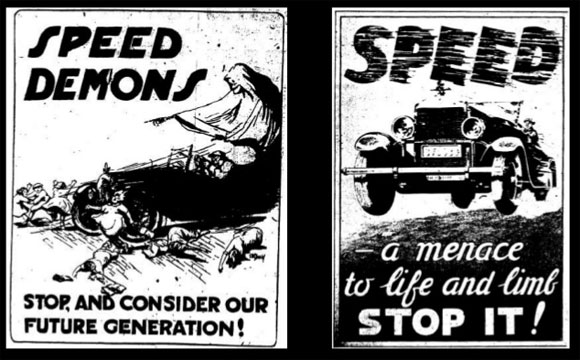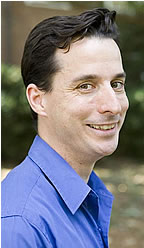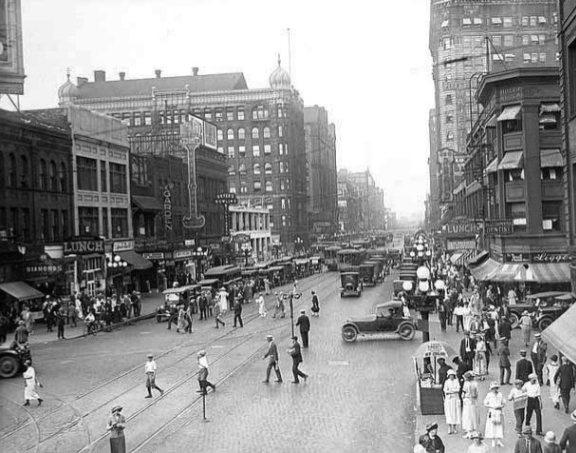Q&A With Peter Norton: History Is on the Side of Vision Zero
1:51 PM EDT on October 16, 2014

Last week, a bunch of bigwigs gathered to talk infrastructure in one of Washington’s most historic and prestigious sites, the Hay-Adams Hotel across the street from the White House. I was offered an opportunity to interview former Transportation Secretary Ray LaHood, former Los Angeles Mayor Antonio Villaraigosa, and a host of other VIPs. But -- no offense to those guys -- the person I wanted to talk to was Peter Norton, listed as the “lead scholar” of the Miller Center’s new commission to “develop innovative, bipartisan ideas on how to create and sustain middle-class jobs through infrastructure policy.”

Norton is a professor at the University of Virginia (where the Miller Center is housed) and the author of Fighting Traffic: The Dawn of the Motor Age in the American City. The book is a chronicle of the battle over who and what streets were for as automobiles were proliferating at the beginning of the 20th century. It's a conversation worth revisiting today.
We had that conversation on a shady park bench in Lafayette Square, one of Washington’s most iconic green spaces, between the Hay-Adams and the White House.
If our interview piques your interest, you can catch Norton in person at the opening reception of the upcoming Vision Zero for Cities Symposium, a national gathering organized by Transportation Alternatives in New York City next month (November 13-15), where public officials and street safety advocates will strategize about "how to achieve Vision Zero in cities around the world."
First let me ask about the Infrastructure campaign that you’re part of here as the lead scholar --
That’s the title!
I have questions about the push for infrastructure investment from the point of view of someone who is skeptical of increasing car infrastructure. Not to start on a negative note, but a lot of the push for increased infrastructure investment is not necessarily choosy about whether that infrastructure goes toward sustainable, ethical, environmentally friendly, city-friendly infrastructure, or whether it’s highways and cars.
Right. When I was invited to this thing, that question that you’re asking was foremost in my mind. And you find yourself thinking, I could stay out of it as a way of saying I don’t really think these discussions are being held in an inclusive way that includes all kinds of ideas, including ones that haven’t been on the table before -- or I could join in and see if I could work in some of those less orthodox perspectives. And I chose the latter. I had some opportunities over the last two days to work in some points of view that weren’t being represented there.
How did you do that?
And I’ll just insert that I’ve been very clear since I joined this thing that I was going to be retaining my independent perspective, and that would include reviewing the reports before they go out and making sure that I’m happy with my association with that.
About the points of view I threw in: There was discussion of congestion and the room seemed to start to fall into the consensus that the solution is, you need more gas tax revenue and that has to go into building more capacity. And I could easily tell that the capacity being imagined here was capacity for automobiles. So I suggested that you can get more capacity for automobiles without building more lanes if you build smarter roads, and this can also help create places that are more inviting to pedestrians, to cyclists. So I gave some well-known examples like New York where they’ve used existing right of ways as opportunities for innovation.
So infrastructure can mean a lot of things. Our mental model is highways. But there’s infrastructure for cycling, there’s infrastructure for pedestrians, and I’m glad to say I think this group recognizes that.
You talk a lot about mobility and access being inversely proportional. That seems like something that could come up in a conversation about congestion.
I did try to bring in the Federal Highway Administration rules that seem to begin with the assumption that the only way anybody wants to go anywhere is by driving. I want to give the administration credit, because it’s recently done things like approve bike boxes, and it’s piecemeal bringing in other assumptions into planning. But because it’s a piecemeal add-on, it still has a legacy that’s very strong of assuming that, for example, if you want a place to have high accessibility, it’s going to have low mobility.

From a pedestrian’s point of view that’s nonsense. Accessibility and mobility, when you’re a pedestrian, are one and the same. The prioritization of speed is a driver’s priority. In cities, if we value speed excessively we end up transforming the city into something that’s not a city. I think we’ve suburbanized our cities in ways that make bad suburbs and bad cities.
I want to talk a little bit about the anti-automobile campaigns from the early part of the 20th century and how you see them connecting to today’s Vision Zero campaigns, or other campaigns not just for better bike lanes and better transit but a fundamental restructuring of the hierarchy of cars at the top.
I like the way you put that: fundamental restructuring. I think the question that gets skipped -- and skipping it has huge implications -- is: What’s a street for? And if you step way back and ask that question, it turns out the assumptions we come to this with are really open to question.
Like the notion that the priority in all streets, or almost all streets, should be motor vehicles. Maybe we could have something closer to an equal sharing of the streets, or maybe we could have some streets be priority-motor vehicles and have some with other priorities. But I’m amazed at what we’ve seen in the last 10 years, especially in terms of reimagining what streets are for.
You mentioned Vision Zero; you could mention complete streets, livable streets, street reclaiming, and all these sorts of things. And they’re beautiful and inspiring, but a lot of them are working against a counter-narrative that says, you guys are all fringe groups, you’re not part of the mainstream here. And I think actually what the history of streets has to offer Vision Zero and complete streets and other movements like that is a chance to prove that actually they’re the ones with the pedigree. They’re the ones with the history. They’re the ones whose assumptions were the so-called normal assumptions of a century ago.
So yeah I think what history has to offer is a rebuttal to the official story that says, you guys are not official.
Do you see echoes of that in the Vision Zero fights today?
Oh yeah. Because when the automobile started appearing in large numbers in American streets, almost exactly 100 years ago, it was a safety crisis of incredible proportions. And the mainstream response to that was, we have to make streets safe from cars, not safe for cars.” That’s not to say you couldn’t have cars in streets --
But they shouldn’t be a danger.
They shouldn’t be a danger. And Vision Zero is a recent rediscovery of the idea that safety is not just safety for drivers. Safety is not just, how do we make speed safe, but do we sometimes need to achieve safety at a cost to speed? So, yeah, I think Vision Zero in a way has a really long history by other names. A hundred years ago it was called Safety First. Safety First was the name, essentially, for Vision Zero. And they actually did some of the same things, which was count the casualties and aim for zero.
Back then, when people were standing up against cars, it seems like they were sort of looked at as anti-progress, anti-technology -- that they were sort of throwbacks. You’ve been skeptical of driverless cars; we’re certainly skeptical of driverless cars -- with something like that, I feel like there’s a danger of, "Well this is the future and you’re stuck in the past." Is there a way to be skeptical of the dangers of automobile technology without getting stuck in that?
I think what the historical example shows is, you start to win when you get control of the story. So actually the winning side, if I can put it like that, were the critics, because they were joined by the officials too. The first generation of traffic engineers was motivated in part by a wish to tame the automobile down for the sake of other street users.
But there was a very ingenious story that started being told by people who wanted more of a future for cars in cities, and that was a story that said: It’s a new age. And they called it the Motor Age. And when you say it’s a new age, that’s a way of saying, the way we’ve been doing it, and the wisdom we’ve been coming to this with, is all open to question now, because we can say it’s outdated.
And I think that’s a really powerful example of what we can do.
Because we can say, oh well, we had a day and a time when we thought, "Okay, let’s see if we can make cities places where everyone can drive wherever they want to and park when they get there." But maybe that day is past now.
And maybe the throwback is the person who says, "We want to build cities where people can drive anywhere they want at whatever speed they want and park when they get there." And maybe the real forward-looking thing is to say that we can’t keep burning fuel at this rate, we can’t tolerate a public health crisis that’s caused by people being sedentary all the time, we don’t want a future where children don’t walk anywhere because it’s not safe to walk anywhere.
And I think that’s a positive story -- and I think it’s a technology-friendly story, because technology can help make more livable cities. Because, for example, instead of widening a highway, we can use technology to more optimally route the traffic. And if that means we don’t widen a highway, or we can divert traffic off of one street and onto another, and make the street we divert it off of more pedestrian-friendly, it’s like everybody’s winning.
So in a way it’s anti-technology to say, "Well we have traffic congestion; widen the road." That sounds almost Stone Age in terms of its thinking.
What has the automobile lobby learned from a century ago? What do you see that they are doing now in the face of this movement toward livability? How are they responding, and are there echoes of the past in there as well?
Oh yeah. And I think it’s a complicated response. So some groups -- I might mention the American Automobile Association as an example -- they’re continuing in a long tradition of seeing themselves, not just as a towing service, but as advocates for people to be able to drive with limited restriction. And they continue to speak a lot about traffic congestion and say we need to rebuild the roads and so on.
But they also -- and the industry too -- are trying to look like people who recognize the future. General Motors has gotten involved in “urban automobiles,” very tiny ones -- they have a vision of a future city where people can park because the cars will be like folding chairs that collapse. And they’re involved also in driverless car development.
And I don’t want to say that all of that is bad -- some it is an appropriate response to pressure, that should tell us that constructive pressure has worked. But I do fear for the idea that the solution is to find a way to let everybody drive everywhere and park when they get there; we just have to do it in a more high-tech way. Because I think that whole notion is a flawed notion. I fear for what that means for livability, for what it means for our cities, for what it means for public heath, for what it means for climate change, and so on.
Drop by tomorrow for part two of Streetsblog's interview with Peter Norton.
Stay in touch
Sign up for our free newsletter
More from Streetsblog USA
Thursday’s Headlines Are Down on Highways
Two outlets recently featured articles on the harmful effects of ongoing freeway projects.
Talking Headways Podcast: Details of Development Reform in Minnesota, Part I
Jim Kumon of Electric Housing discusses his work as a developer and urban policy educator in the Twin Cities.
Thursday’s Headlines Don’t Like Riding on the Passenger Side
Can you take me to the store, and then the bank? I've got five dollars you can put in the tank.
Study: When Speed Limits Rise on Interstates, So Do Crash Hot Spots on Nearby Roads
Rising interstate speeds don't just make roads deadlier for people who drive on them — and local decision makers need to be prepared.
Calif. Bill to Require Speed Control in Vehicles Goes Limp
Also passed yesterday were S.B 961, the Complete Streets bill, a bill on Bay Area transit funding, and a prohibition on state funding for Class III bikeways.




